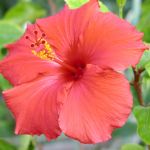| Common Name: |
Chinese Hibiscus |
| Other Names: |
Rose of China, Hawaiian hibiscus |
| Botanical Name: |
Hibiscus rosa-sinensis |
| Genus: |
Hibiscus |
| Family: |
Malvaceae |
| Native Location: |
Tropical Asia |
| Cultivation: |
Well-drained, moist, neutral to alkaline soil in sun. Hibiscus need full sun and warm summers to flower well. Cut back hard in spring. Whitefly, aphids, and spider mite may attack plants under cover. |
| Propagation: |
By seed sown in spring (species only) at 13-18°C (55-64°F); by greenwood cuttings in late spring or semi-ripe cuttings in summer. |
| Harvest: |
Stems are cut for fiber. Leaves are picked when young and used fresh; flowers are cut and dried for infusions and powders. Calyces are collected when mature and used fresh or dried. Seeds for roasting are collected when ripe. |
| Varieties: |
Cooperi
Is compact, with lanceolate leaves, variegated white and often pink tinged.
Height: 1-2m (3-6ft)
Width: 1-2m (3-6ft)
Scarlet Giant
Has bright scarlet flowers, 12-17cm (5-7in) across. |
| Height: |
1.5-3m (5-10ft) |
| Width: |
1.5-3m (5-10ft) |
| Hardiness: |
Z9-11 |
| Parts Used: |
Flowers, juice from petals. |
| Properties: |
A sweet, astringent, cooling herb that checks bleeding, soothes irritated tissues, and relaxes spasms. |
| Medicinal Uses: |
Internally for excessive and painful menstruation, cystitis, venereal diseases, feverish illnesses, coughs, and for hair growth. |
| Culinary Uses: |
Flowers are eaten raw or steamed, and used for coloring foods, such as jellies and preserved fruits. |
| Economic Uses: |
Juice from petals is used in China to make shoe-blacking and mascara. |
| Bibliography: |
Encylopedia of Herbs by Deni Brown Copyright ©: 1995, 2001 Dorling Kindersley Limited pg 235
|
